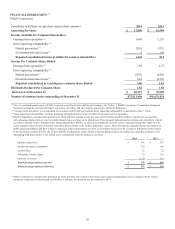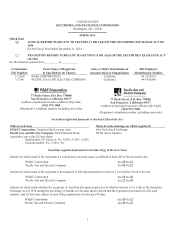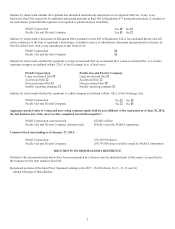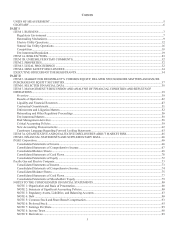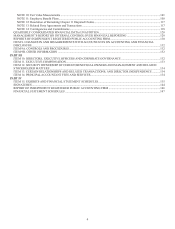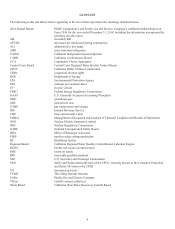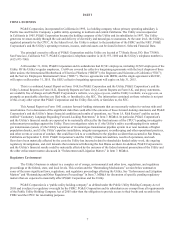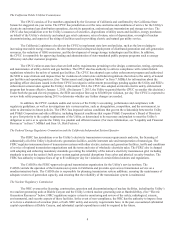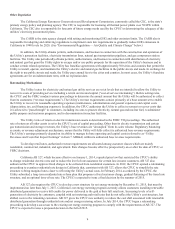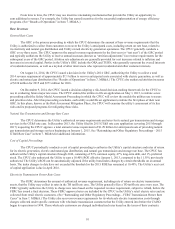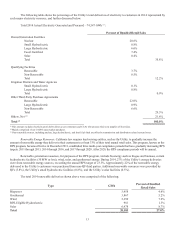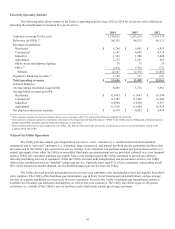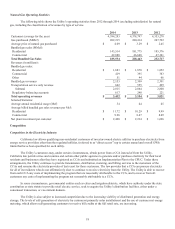PG&E 2014 Annual Report Download - page 17
Download and view the complete annual report
Please find page 17 of the 2014 PG&E annual report below. You can navigate through the pages in the report by either clicking on the pages listed below, or by using the keyword search tool below to find specific information within the annual report.9
Other Regulation
The California Energy Resources Conservation and Development Commission, commonly called the CEC, is the state’s
primary energy policy and planning agency. The CEC is responsible for licensing all thermal power plants over 50 MW within
California. The CEC also is responsible for forecasts of future energy needs used by the CPUC in determining the adequacy of the
utilities’ electricity procurement plans.
The CARB is the state agency charged with setting and monitoring GHG and other emission limits. The CARB also is
responsible for adopting and enforcing regulations to implement state law requirements to gradually reduce GHG emissions in
California to 1990 levels by 2020. (See “Environmental Regulation — Air Quality and Climate Change” below.)
In addition, the Utility obtains permits, authorizations, and licenses in connection with the construction and operation of
the Utility’s generation facilities, electricity transmission lines, natural gas transportation pipelines, and gas compressor station
facilities. The Utility also periodically obtains permits, authorizations, and licenses in connection with distribution of electricity
and natural gas that grant the Utility rights to occupy and/or use public property for the operation of the Utility’s business and to
conduct certain related operations. The Utility has franchise agreements with approximately 300 cities and counties that permit the
Utility to install, operate, and maintain the Utility’s electric and natural gas facilities in the public streets and roads. In exchange for
the right to use public streets and roads, the Utility pays annual fees to the cities and counties. In most cases, the Utility’s franchise
agreements are for an indeterminate term, with no expiration date.
Ratemaking Mechanisms
The Utility’s rates for electricity and natural gas utility services are set at levels that are intended to allow the Utility to
recover its costs of providing service including a return on invested capital (“cost-of-service ratemaking”). Before setting rates,
the CPUC and the FERC conduct various proceedings to determine the annual amount that the Utility will be authorized to collect
from its customers (“revenue requirements”). The Utility’s revenue requirements consist primarily of a base amount set to enable
the Utility to recover its reasonable operating expenses (maintenance, administration and general expenses) and capital costs
(depreciation, tax, and financing expenses). In addition, the CPUC authorizes the Utility to collect revenues to recover costs that
it is allowed to “pass-through” to customers, including its costs to procure electricity, natural gas and nuclear fuel, to administer
public purpose and customer programs, and to decommission its nuclear facilities.
The Utility’s rate of return on electric transmission assets is determined in the FERC TO proceedings. The authorized
rate of return on all other assets is set in the CPUC’s cost of capital proceeding. Other than its electric transmission and certain
gas transmission and storage revenues, the Utility’s base revenues are “decoupled” from its sales volume. Regulatory balancing
accounts, or revenue adjustment mechanisms, ensure that the Utility will fully collect its authorized base revenue requirements.
The Utility’s earnings primarily depend on its ability to manage its base operating and capital costs (referred to as “Utility
Revenues and Costs that Impact Earnings” in Item 7. MD&A) within its authorized base revenue requirements.
To develop retail rates, authorized revenue requirements are allocated among customer classes which are mainly
residential, commercial, industrial, and agricultural. Rate changes become effective prospectively on or after the date of CPUC or
FERC decisions.
California AB 327, which became effective on January 1, 2014, repealed prior law that restricted the CPUC’s ability
to change residential electric rates and to reduce the level of rate assistance for certain low-income customers. AB 327 also
authorized the CPUC to approve fixed charges to be collected from residential customers. In 2012, the CPUC opened a rulemaking
proceeding to examine residential rate design in California that, consistent with AB 327, allows the CPUC to simplify the rate
structure to bring marginal rates closer to reflecting the Utility’s actual costs. In February 2014, as ordered by the CPUC, the
Utility submitted a long-term residential rate reform plan that proposes a fixed customer charge, gradual flattening of the tiered rate
structure, and an optional time-of-use rate. The CPUC is expected to issue a final decision by the summer of 2015.
AB 327 also requires the CPUC to develop a new structure for net energy metering by December 31, 2015, that must be
implemented no later than July 1, 2017. California’s net energy metering program currently allows customers installing renewable
distributed generation to receive bill credits for power delivered to the grid at their full retail rate. Increasing levels of self-
generation of electricity by customers, coupled with net metering and retail rates that do not reflect the Utility’s cost structure, has
shifted costs to the remaining customers. AB 327 gives the CPUC new authority to reduce the cost shift associated with renewable
distributed generation through residential rate and net energy metering reform. In July 2014, the CPUC began a rulemaking
proceeding to develop a successor to the existing net energy metering program to comply with the requirements of AB 327. The
CPUC is expected to issue a proposed decision in the fall of 2015.


